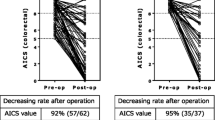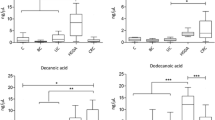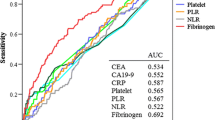Abstract
Plasma CEA levels were determined in 280 patients with histologically proven colorectal carcinoma: in 180 once or twice preoperatively and repeatedly postoperatively, and in 100 postoperatively only. Preoperative levels correlated directly with surgical-pathologic state and inversely with the time of recurrence;i.e., groups of patients with more advanced stage showed higher proportion of elevated CEA levels, and patients with higher levels had recurrences earlier. Levels above 20 ng/ml were strongly suggestive of liver metastases or disseminated disease.
Postoperative plasma CEA levels displayed three patterns of variation. 1) Levels fluctuating within normal range, below 3.2 ng/ml, strongly evidenced that surgery was effective, and 2) those fluctuating below 7.5 ng/ml indicated usually nonmalignant concomitant disease; in either group no more than 10 per cent of the patients had recurrences. 3) Levels rising persistently from a postoperative nadir indicated recurrence or, when the rise was dramatic, liver metastases or disseminated cancer in at least 97 per cent of the patients.
Similar content being viewed by others
References
Wanebo HJ, Stearns M, Schwartz MK. Use of CEA as an indicator of early recurrence and as a guide to a selected second-look procedure in patients with colorectal cancer. Ann Surg 1978;188:481–93.
Astler VB, Coller FA. The prognostic significance of direct extension of carcinoma of the colon and rectum. Ann Surg 1954;139:846–52.
Dukes CE. The classification of cancer of the rectum. J Pathol 1932;35:323–32.
Turnbull RB Jr, Kyle K, Watson FR, Spratt J. Cancer of the colon: the influence of theno-touch isolation technic on survival rates. Ann Surg 1967;166:420–7.
Ackerman LV, del Regato JA. Cancer: diagnosis, treatment and prognosis. 2nd ed. London: H Kimpton, 1954:171.
Broders AC, Buie LA, Laird DR. Prognosis in carcinoma of the rectum: a comparison of the Broders and Dukes methods of classification. JAMA 1940;115:1066–71.
Laskowski J. Podstawy mianownictwa i klasyfikacji raków z punktu widzenia morfologii. Klasyfikacja. Nowotwory 1932;7:119–27.
Gold P, Freedman SO. Demonstration of tumor-specific antigens in human colonic carcinomata by immunological tolerance and absorption techniques. J Exp Med 1965;121:439–62.
Chu TM, Lavin P, Day J, et al. Carcinoembryonic antigen: prognosis and monitoring of cancer. In: Lehmann FG, ed. Carcino-embryonic proteins. Amsterdam: Elsevier/North Holland Biomedical Press, 1979, 1:55.
Herrera MA, Chu TM, Holyoke ED. Carcinoembryonic antigen (CEA) as a prognostic and monitoring test in clinically complete resection of colorectal carcinoma. Ann Surg 196;183:5–9.
Koch M, McPherson TA. Predictive value of plasma CEA in patients with colorectal carcinoma. J Surg Oncol 1979;12:319–25.
Mach JP, Vienny H, Jaeger P, Haldemann B, Egely R, Pettavel J. Long-term follow-up of colorectal carcinoma patients by repeated CEA radioimmunoassay. Cancer 1978;42:1439–47.
Martin EW Jr, Cooperman M, Carey LC, et al. Sixty second look procedures indicated primarily by rise in serial carcinoembryonic antigen. J Surg Res 1980;28:389–94.
Martin EW Jr, James KK, Hurtubise PE, Catalano P, Minton JP. The use of CEA as an early indicator for gastrointestinal tumor recurrence and second-look procedures. Cancer 1977;39:440–6.
Moertel CG, Schutt AJ, Go VL. Carcinoembryonic antigen test for recurrent colorectal carcinoma: inadequacy for early detection. JAMA 1978;239:1065–6.
Nicholson JR, Aust JC. Rising carcinoembryonic antigen titers in colorectal carcinoma: an indication for the second-look procedure. Dis Colon Rectum 1978;21:163–4.
Sorokin JJ, Sugarbaker PH, Zamcheck N, Pisick M, Kupchik HZ, Moore FD. Serial carcinoembryonic antigen assays: use in detection of cancer recurrence. JAMA 1974;228:49–53.
Staab HJ, Anderer FA, Stumpf E, et al. Postoperative CEA follow-up: disease progression and second-look operation. In: Lehmann FG, ed. Carcino-embryonic proteins. Amsterdam: Elsevier/North Holland Biomedical Press, 1979, 1:65.
Staab HJ, Anderer FA, Stumpf E, Fischer R. Carcinoembryonic antigen follow-up and selection of patients for second-look operation in management of gastrointestinal carcinoma. J Surg Oncol 1978;10:273–82.
Staab HJ, Anderer FA, Stumpf E, Fischer R. Slope analysis of the postoperative CEA time course and its possible application as an aid in diagnosis of disease progression in gastrointestinal cancer. Am J Surg 1978;136:322–7.
Wanebo HJ, Rao B, Pinsky CM, et al. Preoperative carcinoembryonic antigen level as a prognostic indicator in colorectal cancer. N Engl J Med 1978;229:448–51.
Winawer SJ. Colorectal neoplasia: current techniques for early diagnosis. NY State J Med 1978;78:1892–4.
Zamcheck N. The present status of CEA in diagnosis, prognosis, and evaluation of therapy. Cancer 1975;36:2460–8.
Hirai H. A collaborative clinical study of carcinoembryonic antigen in Japan. Cancer Res 1977;37:2267–74.
Radwan MW, Hahn L, Szymendera J. Automatyczne przetwarzanie danych w metodach radiokompetycyjnych. Post Fiz Med 1979;14:61–7.
Radwan MW, Hahn L, Szymendera J. Computer program for standard curve fitting and dose interpolation of immunoradiometric “sandwich” assay of CEA: comparison of two fitting models (abstr). Eur J Nucl Med 1979;4:415.
Snedecor GW, Cochran WG. Statistical methods. 6th ed. Ames, Iowa: The Iowa State University Press, 1969.
Patton DD. Introduction to clinical decision making. Semin Nucl Med 1978;8:273–82.
Koszarowski T, Gadomska H, Wronkowski Z, et al. Cancer in Poland, City of Warsaw and selected rural areas, 1963–72. Warsaw: Polish Medical Publishers, 1977:273.
Jubert AV, Talbott TM, Maycroft TM. Characteristics of adenocarcinomas of the colorectum with low levels of preoperative plasma carcinoembryonic antigen (CEA). Cancer 1978;42:635–9.
Wangensteen OH, Lewis FJ, Tongen LA. “Second-look” in cancer surgery: patient with colic cancer and involved lymph nodes negative on “sixth look”. J Lancet 1951;1:303–7.
Author information
Authors and Affiliations
Additional information
Supported by grant PR-6/0209 awarded by the Polish National Cancer Program. Also aided by the National Cancer Institute, NIH, DHEW, under the US-Poland Cancer Program.
About this article
Cite this article
Szymendera, J.J., Nowacki, M.P., Szawlowski, A.W. et al. Predictive value of plasma CEA levels: Preoperative prognosis and postoperative monitoring of patients with colorectal carcinoma. Dis Colon Rectum 25, 46–52 (1982). https://doi.org/10.1007/BF02553548
Received:
Issue Date:
DOI: https://doi.org/10.1007/BF02553548




